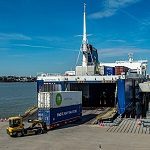
The cargo flowing through our ports varies, but the current supply chain planning and the sentiment from our customers is consistent throughout.
Customs, border and security formalities are about to change in two stages on 1 January and 1 July 2021 for intra-European trade flows, but what’s required?
My dedicated in-house Brexit transition team has been at the heart of discussions with the Border Delivery and Protocol Group and all tiers of the government in England and Scotland as the UK prepares for this new dawn.
The team has also been working collaboratively with our customers to provide Brexit flexible solutions.
Harnessing our vast experience and proven performance of handling rest-of-world trade, I.T. backed border and booking systems, an extensive network of ferry and container connections, and onward rail and road strategic linkages to the largest domestic consumer markets, we will ensure that goods continue to efficiently flow across our borders and onward to their final destination.
Our commitment is to ensure our shelves remain stocked, our NHS is supported, our vehicles fuelled, our industrial base fired and our construction industry thrives by keeping the flow through our ports.
Supply chains are realigning as they seek greater resilience and a low carbon route close to market, and our ports are ideally placed to support through our investment in infrastructure, market leading turnaround times and capacity for growth.
We’ve matched that ambition through a £260 million investment programme in our new port, Tilbury2, and an overhaul of our rail terminals at Tilbury and Grangemouth.
This provides for a 775m long rail hub-to-hub low carbon distribution model for the food, drink and perishables sectors – connecting one of Europe’s largest reefer ports to Scotland’s largest container port.
The growth through our brand new freight ferry terminal operated by P&O Ferries, Tilbury2, is testament to early tremors of the ongoing seaquake.
Despite strong pandemic headwinds, our trade routes have grown substantially.
The Tilbury-Zeebrugge ro-ro route has recorded 7% annualised growth in the first six months of Tilbury2’s operation.
While London Container Terminal at Tilbury has added five new routes in 2020 – stretching from north Africa to Norway – with a 35% increase in European trade this year alone.
Grangemouth has enhanced the frequency of its network connections to northern European’s industrial base through key hubs like Rotterdam, Antwerp and Hamburg, with new calls to the Benelux.
Be assured that Forth Ports is ready for Brexit and we have an appetite and capacity to continue supporting growth of core markets.
In these uncertain times, my team has compiled a useful guide of what’s required and when, alongside a guide to key terms, an overview of our services and our global, European and domestic network connections https://www.forthports.co.uk/forth-ports-group/brexit-ready/